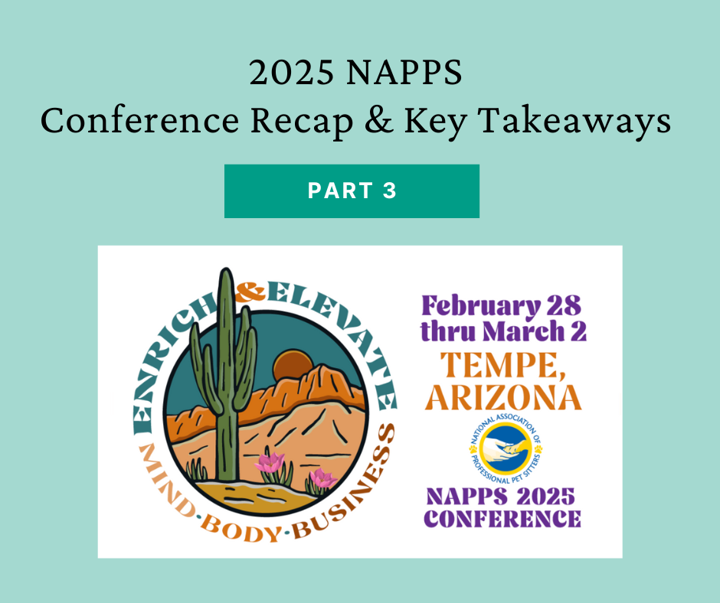
Missed the 2025 NAPPS Conference? Get the full scoop with our three-part series. New to the series? Check out part I here!
Part 3: Real-World Resilience & Your Winning Team
Welcome to the final part of our NAPPS 2025 recap! We're wrapping things up with practical tips and essential preparedness advice. First, we'll learn how to bring 'From Chaos to Control' with Eliza Burr's expert advice. Then, we'll cover crucial emergency preparedness tips from the Arizona Humane Society. Finally, we will talk about building your dream team by recruiting top talent with Joe from WalkerScout. Thanks for joining us on this journey!

From Chaos to Control: Pet Business Tips from Eliza Burr, The Pet Business Coach
Ever hired someone in a pinch? We've all been there – that "need someone yesterday" desperation hire. But as Eliza Burr, The Pet Business Coach, emphasized, "It never works." Instead, focus on the "define" stage and really nail down your ideal employee avatar. And remember, training doesn't stop after the initial onboarding! Continuous follow-up is key. The ultimate goal? To build a business that runs smoothly, allowing you to step back and reclaim your time.
Eliza, a self-proclaimed policy and procedure enthusiast (a rare breed, she admits!), dove into the crucial differences between policies, processes, and procedures. Think of it like this:
- Policy: The goal.
- Process: The broad steps to reach that goal.
- Procedure (SOP): The "how-to" document for each step.
Why are these so important? Consistency, training, and separation. That last one is huge! If all your business knowledge is trapped in your head, you are the business. As Eliza vividly illustrated, it's like a bouncy house. You're the air pump. If you pull the plug (i.e., you're not there), the whole thing deflates. Policies and procedures create that separation, allowing you to step away and gain the freedom you desire.
The Perfect Policy and Avoiding Potholes - Building a Business That Works For You
What does the "perfect" policy look like? It works for everyone: you, your business, your employees, and your clients (in that order!). It also needs to be understandable. Don't be afraid to have others review it for clarity. And, crucially, it needs to drive the desired behavior. If it's not working, ditch it! Don't get attached. These systems are designed to free you, not bind you.
Key policies and procedures to consider include those for time off requests, expense tracking, and sitter pay, as well as client-facing ones like cancellation and late booking policies. For administrative tasks, have clear procedures for payroll, job assignments, and client payments.
Common pitfalls? Ignoring or not using your policies, overly complex documents (no one wants to read a ten-page SOP!), and not having them written down at all. Avoid these mistakes to build a business that can function without your constant intervention.
Attracting Your Ideal Clients and Tech That Works - Creating a Sustainable Business
Just like hiring, marketing requires focus. Forget "shotgun marketing" – it's expensive and hard to delegate. Define your ideal client avatar. Consider geographic, demographic, and psychographic characteristics. Psychographics, understanding your client's feelings and habits, is key to effective targeting.
Give your avatar a name (like "Hetty," as Eliza suggested). This helps you connect with them on a more authentic level. Know where they "hang out" (online and offline) and, more importantly, know their problems. Your business provides solutions, so speak to those needs.
Tech can be a game-changer, but it can also be overwhelming. Eliza's "must-haves" include pet-sitting software like PetPocketbook, and team communication software (like Slack). Utilize technology to automate and streamline, giving you back valuable time.
Delegation and Dealing with Problems - Empowering Your Team, Empowering Yourself
Putting systems in place is the easy part; delegating them is the challenge. Before delegating, ask:
- Are there clear procedures?
- Has the person been adequately trained?
- Are expectations clear?
Even with the best systems, problems will arise. Empower your employees to solve typical issues. Give them the authority to handle certain situations. However, define when you, as the owner, need to be involved (e.g., safety risks, monetary compensation beyond a limit, etc.). By empowering your team, you empower yourself to step away.
Finally, embrace your "control freakiness" (it's often what made you successful!), but don't let it hinder your ability to step back and grow your business. The ultimate goal is to build a business that works for you, not the other way around.

When Disaster Strikes: It's Not Just About You (And Some Real-World Lessons from the Arizona Humane Society)
Alright folks, let's dive into something crucial: preparing pets for evacuations and disasters. Now, when we say "disaster," we're not just talking about the big, dramatic stuff you see on TV. Sure, wildfires, hurricanes, and tornadoes are terrifying, but a disaster can be as simple as a power outage in the middle of an Arizona summer, or a car accident that leaves your pets stranded. The point is, life throws curveballs, and we need to be ready.
Our speaker, representing the Arizona Humane Society, laid out a simple, but often overlooked, mantra: prepare, plan, and practice. Sounds basic, right? But how many of us actually do it?
Preparation is Key:
- Microchip and ID: This is non-negotiable. Pets get scared, they bolt. A microchip and collar with an ID tag are your best bet for a reunion.
- Emergency Kit: Think of it as a "go-bag" for your pets. This should include:
- Five days' worth of food and water (and a manual can opener if necessary!).
- Medications and medical records.
- Bowls and cleaning supplies.
- A first-aid kit.
- Litter box and supplies (for the kitties).
- Sturdy leashes, harnesses, and secure carriers.
- A current photo of you with your pet and a description.
- Favorite toys and blankets for comfort.
- Practice: This is where many people drop the ball. Don't wait until the emergency to try and wrangle your cat into a carrier. Practice putting them in and out, get them used to it. The same goes for harnesses and leashes.
Planning Ahead:
- Safe Haven: Don't scramble to find a place to stay during a crisis. Plan ahead! Identify friends or family who can accommodate you and your pets. Make sure their pets and yours get along.
- Neighborly Help: Trust a neighbor? Give them a key and instructions on how to care for your pets in case you're not home during an evacuation.
- Pet Sitting Services: Discuss emergency plans with your pet sitter. Can they assist during a disaster?
The Real-World Reality (and Some Hard-Learned Lessons):
Arizona Humane Society highlighted the importance of these preparations by detailing the work that their team does in disaster situations. They work with the Red Cross, respond to local emergencies, and even assist other shelters in crisis. Their team has to be prepared for anything, from wildland fires to decontamination procedures. AHS is the designated statewide responder for disasters regarding animals in the state of Arizona.
And let's be real, disaster relief isn't always glamorous. The speaker shared some vivid, and sometimes humorous, stories from the field:
- Visitation Hours: "I learned the hard way that pet parents never come at the same time for visitation," the speaker explained. To manage the chaos and anxiety for both pets and staff, AHS now enforces designated visitation hours.
- Decontamination Drama: The AHS team handles animal decontamination, a process that involves three zones: hot, warm, and cool. They use specialized equipment and procedures to remove contaminants from animals. And yes, even with all the precautions, shaking dogs still spray contaminated water everywhere!
- The Circus Tent Deployment: One particularly chaotic deployment involved AHS setting up a shelter in a pair of circus tents after a school principal refused to allow pets inside. This experience highlighted the need to "prepare for a disaster within a disaster." From snakes in classrooms to malfunctioning AC and coyote encounters, it was a wild ride.
- Vaccination Realities: In AHS shelter settings, pets are typically vaccinated upon intake unless they have physical vaccination records. The speaker noted that in their experience, very few pet parents actually bring those records.
- Dealing with heat: With rising temperatures, and the increased amount of power outages, it is important to have a plan for keeping animals cool. Cool mats, fans, and most importantly lots of water are vital.
These stories drive home the point: disasters are unpredictable, and preparation is paramount.
The message is clear: our pets rely on us. By taking the time to prepare, plan, and practice, we can ensure their safety and well-being during any emergency. And remember, sometimes, even the best-laid plans go awry, but a little preparation can make a world of difference.

Recruiting Top Talent: Key Strategies for Your Business (and Minimizing Turnover)
This session was packed with actionable insights on recruiting, presented by Joe Latona from WalkerScout. Joe's passion for team building was evident, drawing inspiration from figures like Frank Lloyd Wright, who emphasized learning by doing. This resonated with us, highlighting the importance of giving people opportunities to grow, regardless of their starting point. As Joe pointed out, in business, we're all constantly learning and striving for "sufficient proficiency" rather than unattainable perfection.
While AI is a hot topic, Joe focused on the enduring importance of human connection in recruiting. WalkerScout, founded in 2019, specializes in the pet industry, prioritizing animal safety, fair processes, and helping clients build strong teams. With a team of recruiters conducting thousands of interviews annually, they're saving businesses significant time and effort. WalkerScout supports over 50 small businesses, which speaks volumes about their effectiveness.
Joe shared several key recruiting philosophies that any business can adopt:
- Diversify opportunity sharing: Don't rely on a single platform to find candidates.
- Keep job posts short and concise: Grab attention quickly.
- Make applications easy and short: Don't deter candidates with lengthy processes.
- Offer flexibility in scheduling interviews: Accommodate candidates' needs.
- Embrace virtual interviews: They offer convenience and facilitate better engagement.
- Conduct background and reference checks: Offer positions contingent on these checks in a tight labor market.
Joe emphasized the current labor market dynamics, highlighting that there are still more job openings than people looking for work. In the pet industry, quality hires are crucial for ensuring animal safety.
He also addressed common challenges in recruiting, such as low candidate volume and quality, no-shows, and denied job offers. To tackle low candidate volume, Joe stressed the importance of diversifying candidate sources. He provided a list of places to source candidates, including:
- Sponsored listings
- Organic listings
- A well-optimized career page
- Industry-specific job boards
- Referrals (with incentives)
- Social media (with caution, as most users aren't actively seeking jobs)
- Google Jobs
- Applicant Tracking Systems (ATS)
- Physical media (like QR codes in strategic locations)
Understanding your conversion rate (the percentage of job seekers who become applicants) is also critical. Joe noted that conversion rates have generally decreased, and a good understanding of this will help you determine how many people need to see your listing to get enough applicants. He also provided tips on crafting effective job posts, emphasizing the need for compelling calls to action and concise language (aiming for 300-400 words). He cautioned against relying solely on AI-generated content without human touch and advocated for tools like Grammarly to refine the language.
Application design is often overlooked, but Joe stressed its importance. He recommended keeping applications for entry-level positions under five minutes, limiting clicks, asking only necessary questions, and ensuring mobile-friendliness. Conditional logic forms can help automate the screening process, but human oversight is still essential.
Joe also discussed the selection ratio (the number of applicants needed per hire), noting that for WalkerScout's clients last year, it averaged 75 applicants per hire. This metric can help businesses identify potential issues with their job postings or requirements.
To improve candidate quality, Joe recommended focusing on callback rates, highlighting the importance of quick responses to applications. He also emphasized the need to showcase the company's attributes, benefits, competitive wages, and company culture. He advised consulting a bookkeeper to determine appropriate wage levels and stressed the importance of pay transparency.
Interview attendance and job offer acceptance rates were also discussed. Joe recommended using appointment scheduling software with reminders to minimize no-shows. He also advocated for offering multiple interview options, embracing virtual interviews, and using AI note-taking tools to enhance the interview process. He discussed the pros and cons of asynchronous interviews and emphasized the importance of in-person or video interviews for client-facing roles.
Minimizing New Hire Turnover
Joe addressed new hire turnover, emphasizing the importance of realistic job previews through videos and thorough training. Unexpected factors can lead to turnover, but clear expectations and consistent job descriptions are crucial. A 20% total turnover rate is problematic in the pet industry, as the work is complex.
Exit Interviews and Continuous Improvement
Exit interviews provide valuable feedback. Use Zoom or asynchronous platforms to encourage honesty. Consider having someone other than the owner conduct the interview. Positive feedback can be leveraged for reviews on platforms like Indeed and Glassdoor.
Time to Fill and Cost of Hire
Factors influencing time to fill include job visibility, job requirements, brand reputation, competitive wages, and the speed of job offers. The cost of hire highlights the importance of employee retention.
AI Note-Takers and Efficient Interviews
AI note-taking tools like Grain record and summarize interviews, allowing for quick review of key points and reducing bias. These tools help streamline the interview process and enable deeper engagement with candidates.
In essence, successful recruiting involves a blend of human connection, strategic use of technology, and a commitment to continuous improvement.
And that's a wrap! We hope you've enjoyed our recap of the NAPPS 2025 Conference. Remember, building a thriving pet care business is all about continuous learning, staying connected, and taking care of yourself and your team. By implementing these tips and strategies, you're well on your way to creating a business you love. Thanks for hanging out with us, and we hope to see you next year at the 2026 NAPPS Conference in North Carolina!
